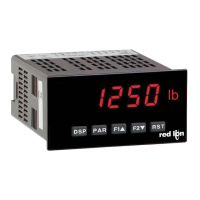3
Installation
The PAX meets NEMA 4X/IP65 requirements for indoor use when
properly installed. The unit is intended to be mounted into an enclosed panel.
Prepare the panel cutout to the dimensions shown. Remove the panel latch and
cardboard sleeve from the unit and
discard the cardboard sleeve.
Slide the panel gasket over
the rear of the unit to the
back of the bezel. The
unit should be installed
fully assembled. Insert
the unit into the panel
cutout.
While holding the unit in place, push the panel latch over the rear of the unit
so that the tabs of the panel latch engage in the slots on the case. The panel
latch should be engaged in the farthest forward slot possible. To achieve a
proper seal, tighten the latch screws evenly until the unit is snug in the panel
(Torque to approximately 7 in-lbs [79N-cm]). Do not over-tighten the screws.
Installation Environment
The unit should be installed in a location that does not exceed the operating
temperature and provides good air circulation. Placing the unit near devices
that generate excessive heat should be avoided.
The bezel should only be cleaned with a soft cloth and neutral soap product.
Do NOT use solvents. Continuous exposure to direct sunlight may accelerate
the aging process of the bezel.
Do not use tools of any kind (screwdrivers, pens, pencils, etc.) to operate
the keypad of the unit.
1.0 INSTALLING THE METER
PANEL CUT-OUT
SETPOINT ALARMS PLUG-IN CARDS (PAXCDS)
The PAXR series has four setpoint alarm output plug-in cards. Only one of
these cards can be installed at a time. (Logic state of the outputs can be reversed
in the programming.) These plug-in cards include:
Dual relay, FORM-C, Normally open & closed
Quad relay, FORM-A, Normally open only
Isolated quad sinking NPN open collector
Isolated quad sourcing PNP open collector
The card can be installed initially or at a later date. Each optional plug-in card
is shipped with complete installation instructions, however, programming
should be reviewed in Module 6.
OPTIONAL PLUG-IN CARDS
2.0 SETTING THE JUMPER AND DIP SWITCHES
2.1 SETTING THE JUMPER
The meter has one jumper for user input logic. When using the user inputs,
this jumper must be set before applying power. The Main Circuit Board figure
shows the location of the jumper and DIP switches.
The user input jumper
determines signal logic for
the user inputs, when they
are used with user functions
or for input signal direction.
All user inputs are set by
this jumper.
2.2 SETTING THE INPUT DIP SWITCH
The meter has three DIP switches for Input A terminal set-up that must be
set before applying power. Switches 4, 5, and 6 are not used.
SWITCH 3
HI Frequency: Removes damping capacitor and allows max. frequency.
LO Frequency: Limits input frequency to 50 Hz and input pulse widths to 10
msec.
SWITCH 2
SRC.: Adds internal 3.9 KΩ pull-down resistor, 7.3 mA max. @ 28 VDC,
V
MAX
= 30 VDC.
SNK.: Adds internal 7.8 KΩ pull-up resistor to +12 VDC, I
MAX
= 1.9 mA.
SWITCH 1
LOGIC: Input trigger levels V
IL
= 1.5 V max.; V
IH
= 3.75 V max.
MAG: 200 mV peak input (must also have SRC on)

